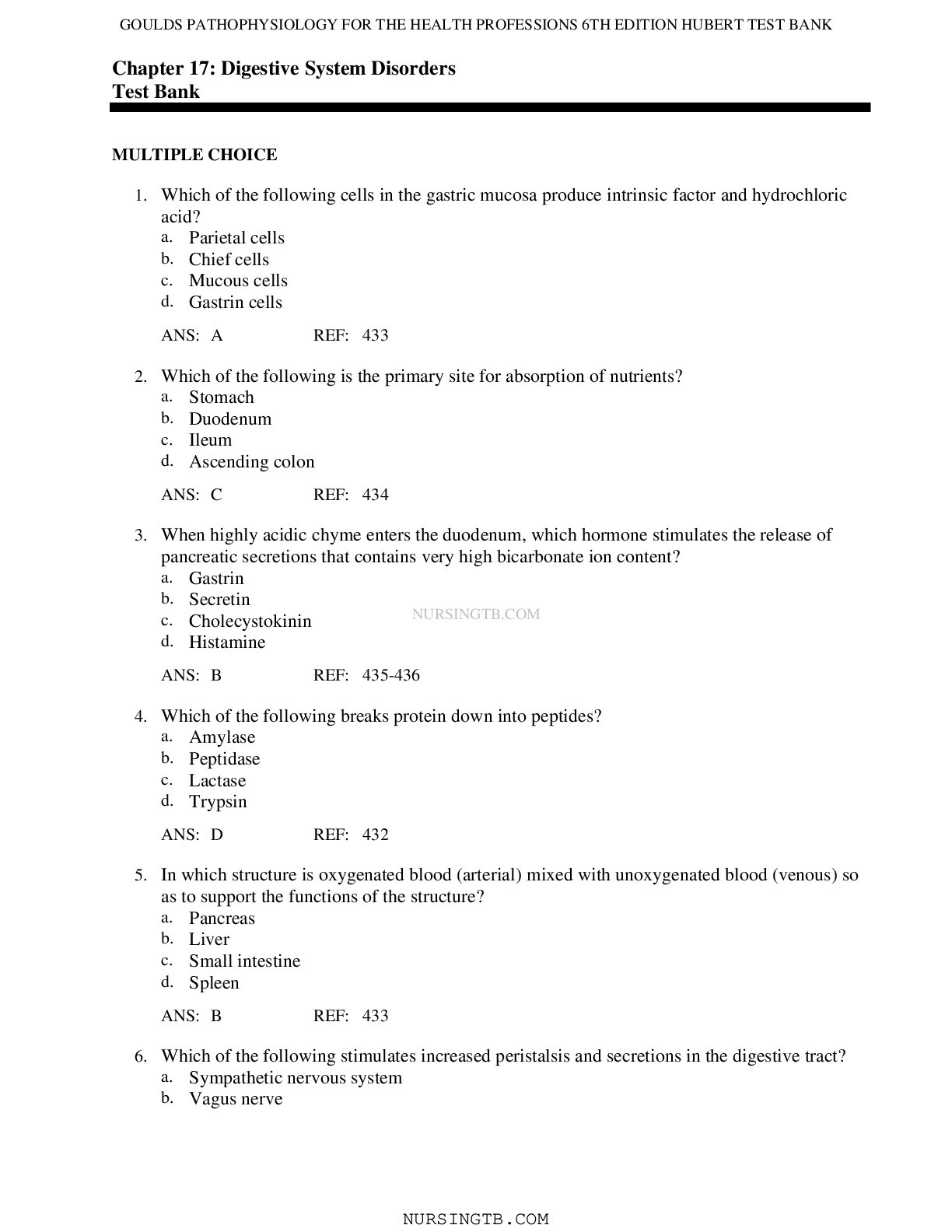All study resources > Chapter 17: Digestive System Disorders Test Bank (Nursing)
Chapter 17: Digestive System Disorders Test Bank
1. Which of the following cells in the gastric mucosa produce intrinsic factor and hydrochloric
acid?
a. Parietal cells
b. Chief cells
c. Mucous cells
d. Gastrin cells
ANS: A REF: 433
2. Which of the following is the primary site for absorption of nutrients?
a. Stomach
b. Duodenum
c. Ileum
d. Ascending colon
ANS: C REF: 434
3. When highly acidic chyme enters the duodenum, which hormon
...[Show More]
1. Which of the following cells in the gastric mucosa produce intrinsic factor and hydrochloric
acid?
a. Parietal cells
b. Chief cells
c. Mucous cells
d. Gastrin cells
ANS: A REF: 433
2. Which of the following is the primary site for absorption of nutrients?
a. Stomach
b. Duodenum
c. Ileum
d. Ascending colon
ANS: C REF: 434
3. When highly acidic chyme enters the duodenum, which hormone stimulates the release of
pancreatic secretions that contains very high bicarbonate ion content?
a. Gastrin
b. Secretin
c. Cholecystokinin
d. Histamine
ANS: B REF: 435-436
4. Which of the following breaks protein down into peptides?
a. Amylase
b. Peptidase
c. Lactase
d. Trypsin
ANS: D REF: 432
5. In which structure is oxygenated blood (arterial) mixed with unoxygenated blood (venous) so
as to support the functions of the structure?
a. Pancreas
b. Liver
c. Small intestine
d. Spleen
ANS: B REF: 433
6. Which of the following stimulates increased peristalsis and secretions in the digestive tract?
a. Sympathetic nervous system
b. Vagus nerve
NURSINGTB.COM
GOULDS PATHOPHYSIOLOGY FOR THE HEALTH PROFESSIONS 6TH EDITION HUBERT TEST BANK
NURSINGTB.COM
c. Increased saliva
d. Absence of food in the system
ANS: B REF: 435
7. Which of the following is contained in pancreatic exocrine secretions?
a. Bicarbonate ion
b. Hydrochloric acid
c. Activated digestive enzymes
d. Insulin
ANS: A REF: 435
8. The presence of food in the intestine stimulates intestinal activity but inhibits gastric activity
through the:
a. defecation reflex.
b. enterogastric reflex.
c. vomiting reflex.
d. autodigestive reflex.
ANS: B REF: 435
9. Which of the following processes is likely to occur in the body immediately after a meal?
a. Lipolysis
b. Ketogenesis
c. Gluconeogenesis
d. Glycogenesis
ANS: D REF: 433
10. What does the term gluconeogenesis refer to?
a. Breakdown of glycogen to produce glucose
b. Conversion of excess glucose into glycogen for storage
c. Formation of glucose from protein and fat
d. Breakdown of glucose into carbon dioxide and water
ANS: C REF: 433
[Show Less]
